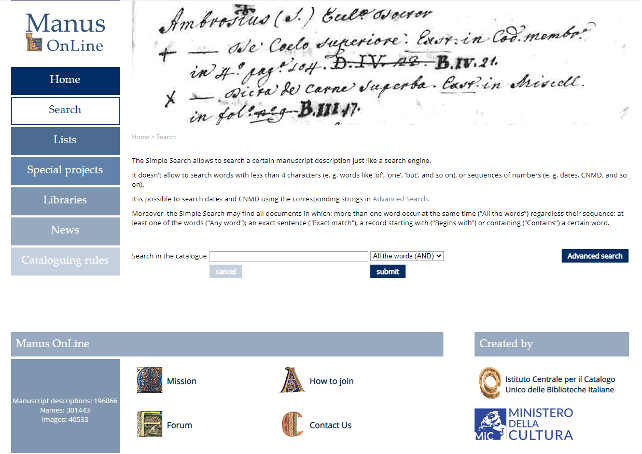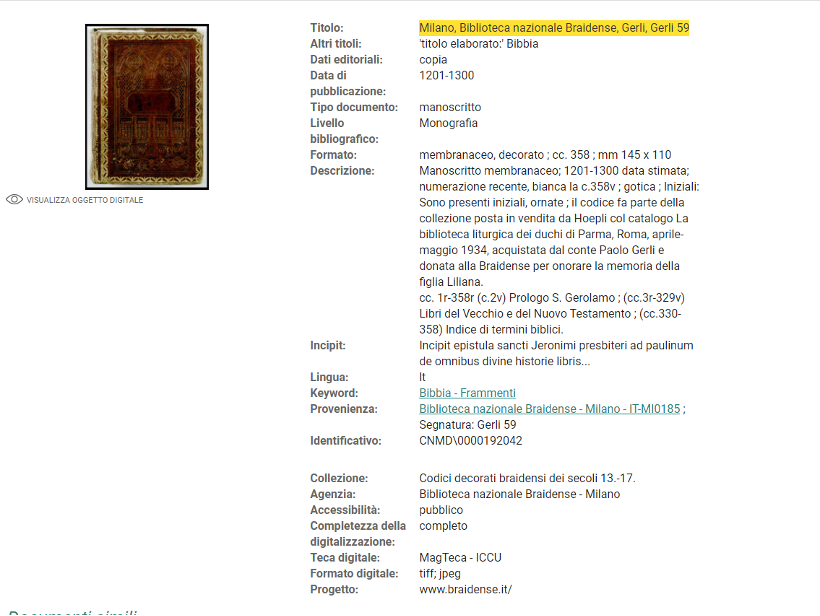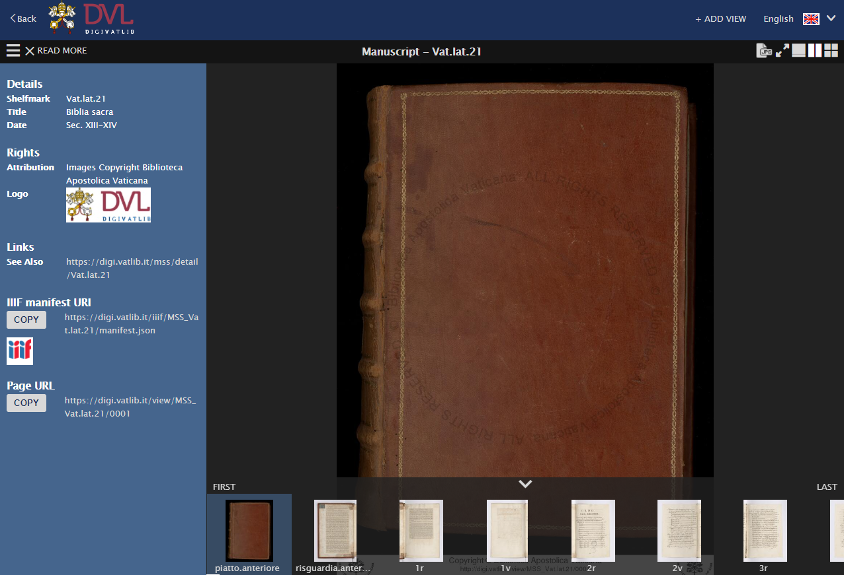Bible Hunting. Where to find data? The case of Italy and the Vatican
This post will investigate the digitized collections available in the Italian peninsula. With the increasing interest in the study of manuscript collections, as well as the need for preservation of manuscripts, digitization has proven itself to be a fundamental part of the research process. The purpose of this investigation is to focus on the availability of digital resources in Italy with the possibility of downloading and re-using images taken from medieval manuscripts into other environments.
Italian digitization initiatives are not immediately intuitive to medievalists , so this blog tries to give an overview of the main resources that are accessible to a general public online. These projects include the general catalogue of manuscripts in Italian libraries, the Digital Library of the Vatican, and other local projects that have been growing in numbers in recent years.
ManusOnline and Internet Culturale
ManusOnLine represents the fundamental resource to search for manuscripts in public, private, or ecclesiastical libraries in Italy. This database, started in 1988 by the Central Institute for a Unique Catalogue (ICCU) with the localisation and cataloguing of all Latin manuscripts from the Middle Ages to the present, later expanded to include every kind of manuscript present in Italian libraries. From the information on the website, we see that 496 institutions are collaborating, but that it is also open to any researcher who would like to contribute to the manuscript files. Any kind of data added would go through a process of review before being published to keep the site institutionally rigorous. In ManusOnLine, you can search for keywords in all available databases or find specific libraries to start your research from. The website also includes digitized images of specific manuscripts, if available, and item-level notes and metadata. The interface is translated into English, whereas the content remains in Italian.
 Fig. 1. Search page, ManusOnLine, ©ManusOnline, ICCU
Fig. 1. Search page, ManusOnLine, ©ManusOnline, ICCU
Search results are given by location, library, collection, and shelfmark. So, the more detailed information you have, the easier it will be to find the right manuscript. Unfortunately, there are no filters available for the results, which makes the process of refining the research challenging. Upon selecting a manuscript, all available data is shown including information about the binding, the manuscript’s content, the provenance, and sometimes digitised pictures are even available (in the example below, indicated by the little icon on the right).
 Fig. 2. Example of search result with digitisation, ManusOnLine.
Fig. 2. Example of search result with digitisation, ManusOnLine.
If a manuscript is digitized, as in the example above, ManusOnLine provides a link to another platform: Internet Culturale. The link directs to a digitised version of the manuscript, which can be downloaded, manipulated, and read.
Internet Culturale is an online platform that aims to be a repository for all the digital catalogues and collections in Italian libraries. It contains different kinds of files (books, manuscripts, cds, dvds, audio files). For the research of the Paris Bible Project, it is easier to use than ManusOnLine. It is more intuitive and the research is helped through filters for date, bibliography, authors, editors, publication location, cataloguing, language, libraries, etc. At the moment, the interface is only available in Italian.
 Fig. 3. Gerli 59, Biblioteca Nazionale Braidense, Milan. Visualisation of a record of a digitized manuscript found in Internet Culturale. © InternetCulturale, ICCU
Fig. 3. Gerli 59, Biblioteca Nazionale Braidense, Milan. Visualisation of a record of a digitized manuscript found in Internet Culturale. © InternetCulturale, ICCU
The digitized version of a manuscript contains all the metadata available from the library with the link to the specific project that was in charge of its digitisation. In this case, the manuscript Gerli 59 comes from the Braidense National Library in Milan and is part of the digital library “MagTeca.” InternetCulturale aspires to be the place where all the different projects of digitisation merge in one location. Everything published on InternetCulturale is accessible through Creative Commons License, which allows the user to download the images and use them for their purposes as long as no profit is made.
Biblioteca Digitale Vaticana
One of the most remarkable digitization projects on the Italian peninsula is DigitaVaticana, which aims to digitize and publish the huge manuscript collections belonging to the Vatican Libraries. Started in 2013, the project has already made possible the publication of 21,449 manuscripts out of the 80,000 present in the Apostolic Library. These manuscripts are available on the website; the user can look for catalogues and digital collections and then download individual pages or obtain a IIIF manifest for using the manuscript in a viewer elsewhere. By adhering to the IIIF standard, the manifest becomes accessible and usable by anyone. It is possible to search either by collection or by shelfmark identifier. Generally, the rights are reserved for the Vatican Apostolic Library and a watermark is applied to the images downloaded. However, this does not hinder the readability of the folios.
 Fig. 4. Example of manuscript, Vat. Lat. 21, digitised. © Vatican Library
Fig. 4. Example of manuscript, Vat. Lat. 21, digitised. © Vatican Library
Overall, it is not difficult to use, although sometimes it can be hard to navigate among the different links connected to the same manuscript containing information and metadata. The interface is available in English, Italian, and Japanese. In the next year, this digital collection will hopefully grow even more, resulting in a large, fascinating database of manuscripts available freely and openly.
Other resources/projects
As mentioned above, Italy also has local digitization projects in addition to universities or libraries across the country. An example of these initiatives is the Teca Digitale (Digital Library) of the Biblioteca Medicea Laurenziana in Florence, which allows the user to view specific digitized manuscripts. As of yet, it is not possible to download them. Another project is the Nuova Biblioteca Manoscritta, managed by Ca’ Foscari University in Venice, which aims at collecting the digitized manuscripts of the Veneto region in collaboration with local libraries.
If you have additional suggestions for exploring digitized collections of manuscripts in Italy not covered here, drop us a line at parisbible (at) gmail (dot) com.
Niccolò N. Cappelletto
Further readings and presentations:
- https://manus.iccu.sbn.it/ricerca.php?lang=en
- https://www.internetculturale.it/
- https://digi.vatlib.it/
- http://mss.bmlonline.it/Catalogo.aspx
- https://www.nuovabibliotecamanoscritta.it/Generale/index.html?language=it&
- Ciancio, Laura. (2010). “Internet Culturale. Cataloghi e Collezioni digitali nelle biblioteche italiane”. La nuova versione del portale. Digitalia, Anno V, Numero 2. 123-134.
You can also consult the bibliography of the project on Zotero.
Suggested citation
Cappelletto, Niccolò Acram (31 October 2022). Bible hunting: where to find data? The case of Italy and the Vatican. Paris Bible Project. https://doi.org/10.5281/zenodo.8040632
This post is published with a CC BY-SA-NC 4.0 International license.